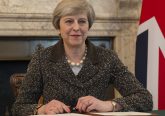[twitter_follow username=”@StephenDFisher” language=”en”]
The single most likely outcome of the May general election is a seriously hung parliament with the Conservatives as clearly the largest party but a majority on the left.
Forecasters, academic experts, journalists, pollsters and the betting markets have long been forecasting a seriously hung parliament with both major parties not only short of the 326 seats required for an overall majority but even forecast to get less than 300 seats. Meanwhile, an SNP landslide is expected in Scotland which would be hugely damaging for Labour and have major implications for the government formation process. If the forecasters and betting markets are right in their central forecasts then Con+LD+DUP combined will be short of a majority and so a Labour led government should form if they can secure the support of the SNP and probably others, including the Liberal Democrats, will be needed too: a potentially messy and unstable situation but also one where there is sufficient similarity in ideological perspective for policy agreement on plenty of issues.
But there is uncertainty associated with all the forecasts and some forecasters are trying to estimate the extent of that uncertainty, which in turn can be used to calculate probabilities of particular events (hung parliament, largest party, etc.)
The three main probabilistic forecasters are the electionforecast.co.uk and Polling Observatory teams and myself at ElectionsEtc.com. We all use fairly similar methods but with some differences in modelling assumptions and scope of data sources. We have different central forecasts and different levels of uncertainty, but we all agree that there is a lot of uncertainty, with prediction intervals (ranges of reasonably probable outcomes) varying from +/- 25 to +/-45 seats. As a result we are all unsure who will emerge as the largest party on seats. Currently the highest probability from any of us is 67 per cent for the Tories from ElectionsEtc.com
These prediction intervals are not just niceties but need to be taken seriously. In 2010 the polls suggested that the Liberal Democrats were on course to get 80+ seats, but they got 57. Famously in 1992 the polls were showing Labour ahead but the Tories won a majority. Late swing and polling error can be considerable and unpredictable as the recent salutary example from Israel shows. If the polls are out in this election by as much as they were there, then either of the main parties could end up with a majority.
Uncertainty estimation and probabilistic forecasting is also valuable for understanding the relative chances of different kinds of governments emerging after the election. The graphic below shows the latest ElectionsEtc.com forecast. The pie chart on the right gives probabilities that different combinations of parties will have majorities (more than 323 seats given that Sinn Fein do not take theirs). While there are often several different combinations of parties that could command a majority, I have made simplifying assumptions as to which grouping would in effect sustain the government. Whether it would be a coalition, confidence-and-supply or some other kind of agreement is not addressed here; that is less important for policy than which parties are involved.
Starting from the top of the pie chart and working clockwise. There is an 8 per cent chance still of a Tory majority, if they are just short of a majority they could call on the DUP, or if that is not enough then the Liberal Democrats or perhaps both if needs be. UKIP do not appear because they are only expected to get four seats and I have assumed that a deal involving both UKIP and LD would be too difficult. As a result of the limited number and size of potential governing partners for the Tories, there is only a 42 per cent chance of a Conservative led government, even though there is a two thirds chance of the Tories being the largest party (on votes or seats).
Conversely starting from the top of the pie chart and working anti-clockwise shows the relative chances of different Labour led governments. As with the Tories Labour would also call on the DUP and Liberal Democrats first if those parties were sufficient to yield a majority, on the basis that the SNP will be harder for Labour to do a deal with, especially given their differences over Trident. But if it were necessary to appeal to the SNP support and SNP support was sufficient to give Labour a majority then a Lab-SNP deal would probably form without any other parties. Experience from other countries suggests that a majority-commanding group of parties is more likely to control the government the fewer parties there are in the group was well as greater the ideologically similarity between them.
The single most likely outcome (central forecast) is at the bottom of the pie chart and that is a seriously hung parliament with the Conservatives as clearly the largest party but a majority on the left, including the SNP and Liberal Democrats. It is not clear that this diverse group of parties would be able to sustain a stable government and it is difficult to say what form it would take if there is one. However, we do know the SNP will not be taking ministerial posts and if there is a three-way deal between Labour, the SNP and Liberal Democrats, they should be able to rely on the Greens, Plaid Cymru and the SDLP not to gang up against them with the Tories if the small parties ended up pivotal.
This post is part of our Decision 2015 series.









No Comment